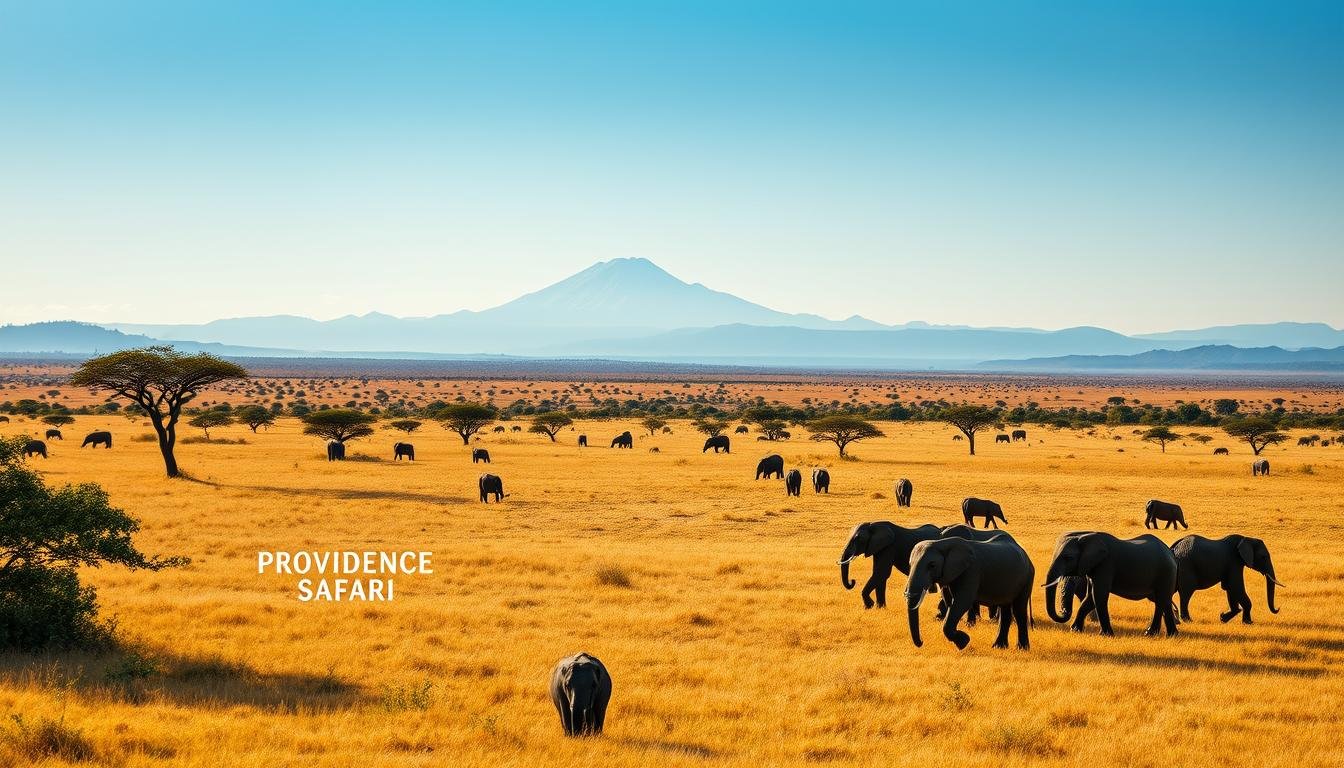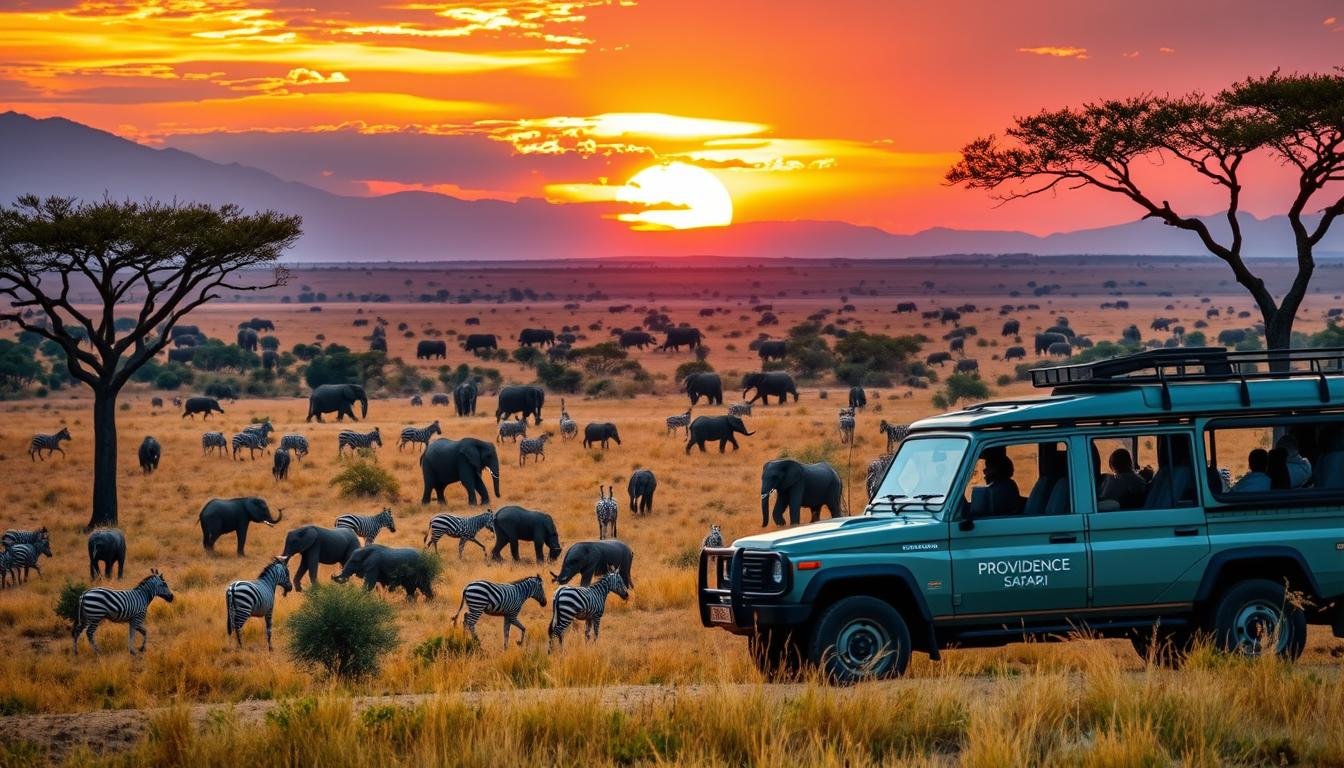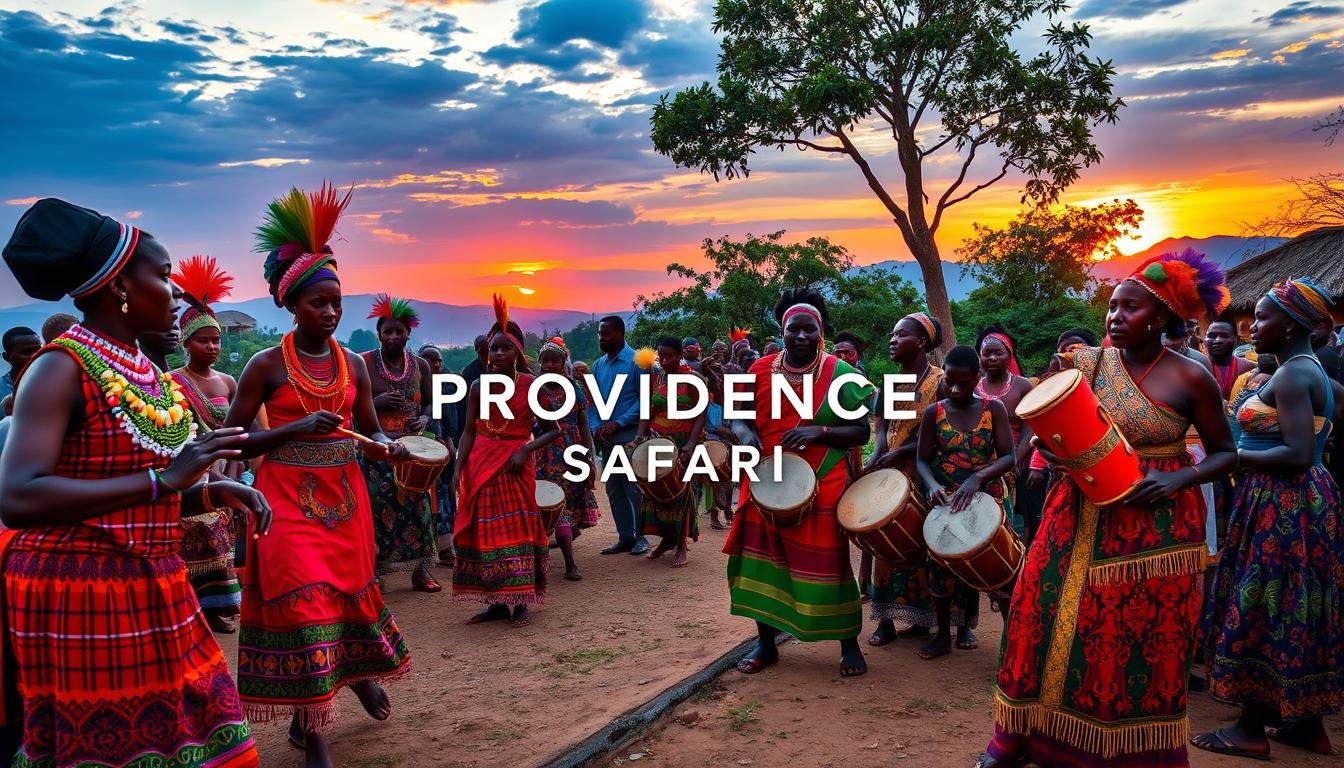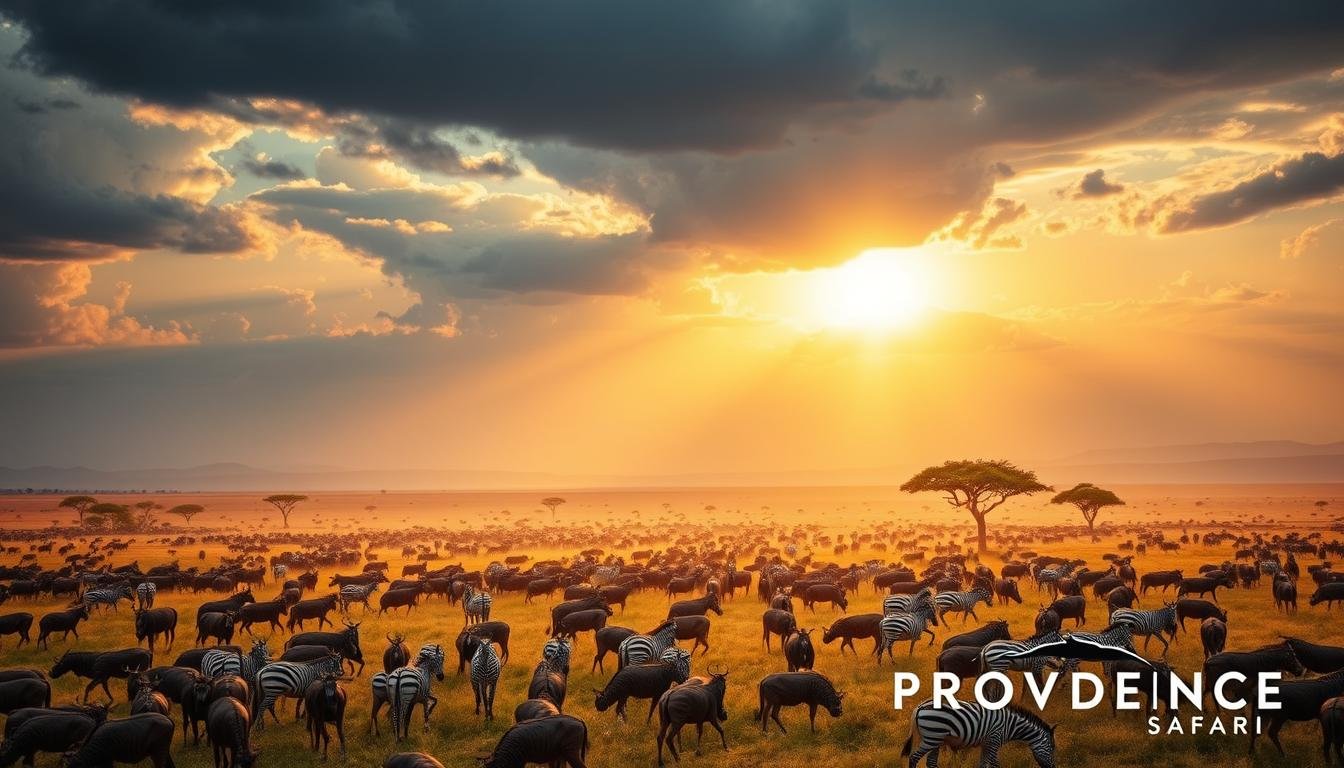
28 Nov
Safari in Tanzania best time: Planning the perfect safari in Tanzania means choosing the right time. The country is known for its wildlife and stunning landscapes. But, the best time to visit depends on what you want to see and do. We’ll look at the best safari times in Tanzania, including the weather, animal behavior, and tourist seasons.
Key Takeaways
- Tanzania’s diverse climate and seasons offer distinct safari experiences throughout the year.
- The dry season from June to October is a prime time for optimal wildlife viewing, while the wet season from November to May provides a unique opportunity to witness the lush, green landscapes.
- Peak safari months fall between June and October, when large concentrations of wildlife can be observed, including the famous Great Migration.
- Visiting lesser-known parks during the wet season can provide a more intimate and less crowded safari experience.
- Timing your safari with cultural events and festivals can enhance your overall experience in Tanzania.
Understanding Tanzania’s Climate and Seasons
Tanzania is a top spot for safari lovers, with a climate that changes the game for your trip. Knowing the weather and seasons is key to a great safari. It helps you see the best of Tanzania’s wildlife and nature.
Overview of Tanzania’s Climate Patterns
Tanzania has a tropical climate, with warm temps and some rain all year. It has two main seasons: the dry season and the wet season. Knowing these seasons is vital for planning your tanzania safari best season.
Distinction Between Wet and Dry Seasons
The dry season is from June to October, with cooler and drier weather. This is the best weather for tanzania game drives, with clear skies and less rain. It’s perfect for seeing wildlife.
The wet season is from November to May, with more rain and greenery. It’s not as easy, but you’ll see Tanzania’s beauty change. You’ll also see migratory birds.
SeasonTimingCharacteristics
Dry Season
June to October
Cooler temperatures, minimal rainfall, favorable for wildlife viewing
Wet Season
November to May
Increased precipitation, lush vegetation, arrival of migratory birds
Knowing Tanzania’s climate and seasons helps you plan your safari. You’ll see the best of Tanzania’s wildlife and nature.
The Dry Season: A Prime Time for Safaris
Planning a Tanzania safari? The dry season, from June to October, is the best time. It offers many benefits for an unforgettable dry season tanzania safari experience.
Advantages of Traveling During Dry Season
Visiting Tanzania in the dry season means better wildlife visibility. Animals gather at water sources, making them easier to see. The dry landscapes also give you clear views of nature’s wonders.
The dry season also means comfortable temperatures. The cooler, drier air is perfect for enjoying your safari. You won’t have to deal with too much heat or humidity.
Wildlife Visibility and Behavior
- In the optimal months for tanzania wildlife viewing, animals are more visible. They gather at waterholes, making them easier to spot.
- The open landscapes offer clear views. You can see wildlife’s natural behaviors and interactions.
- There’s less mosquito activity, which lowers the risk of malaria. This makes your safari safer and more enjoyable.
Want to see the wildebeest migration or spot big cats? The dry season is the best time. It offers great wildlife visibility, comfortable weather, and fewer mosquitoes. No wonder it’s a favorite among safari lovers.
The Wet Season: A Unique Experience
The wet season in Tanzania, from November to May, is a special time for safaris. It’s not as popular as the dry season, but it’s full of rewards for the brave traveler. You’ll see the landscape change and enjoy fewer crowds and better wildlife views.
Benefits of Going on Safari in the Wet Season
Visiting Tanzania in the wet season means seeing lush, green landscapes. The dry areas come alive with rain, making the plants grow strong. This makes our wildlife sightings even more special.
Bird-watchers will love the wet season too. Many birds migrate here, filling the skies with color and life. You can see everything from flamingos to eagles, perfect for photos.
Another plus is the fewer people around. Most tourists go in the dry season. So, we get a more personal safari experience. It’s quieter and more peaceful, letting us enjoy Tanzania’s beauty more.
Choosing the wet season lets us see Tanzania’s wild side in all its glory. The scenery is stunning, and the bird-watching is unmatched. It’s a safari adventure you won’t forget.
Peak Safari Months: June to October
Planning the ultimate Tanzania safari? The peak season from June to October is the best time. It’s dry season, which means better wildlife viewing. It’s perfect for wildlife lovers and adventure seekers.
Reasons for High Tourist Traffic
Many tourists flock to Tanzania in the peak months. The dry season brings animals to water sources, making them easier to see. You can also see the Great Migration, where millions of animals move in search of food.
Events and Wildlife Movements to Consider
- The Great Migration peaks between July and October, offering the best chances to witness this natural spectacle.
- Many animals, such as lions and leopards, are more active during the day as they hunt for prey around the limited water sources.
- Various cultural festivals and events, like the Kilimanjaro Day celebrations in August, add to the excitement and cultural immersion during this peak season.
Looking for the Great Migration or the Big Five? The peak safari months from June to October are the best. Knowing why it’s busy and what to see, you can plan an unforgettable safari.
The Green Season: November to May
The dry season from June to October is great for safari in Tanzania. But, the green season from November to May is special too. It’s when the landscapes are lush and wildlife is plentiful. This makes it perfect for those who want to see the best weather for tanzania game drives.
Definition and Characteristics
The green season, or “shoulder season,” is when Tanzania’s landscapes turn green. This happens during the “short rains” from November to December and the “long rains” from March to May. These rains make the land fresh and green, perfect for your safari.
Ideal Conditions for Bird Watching
- The green season is great for bird watching. Migratory birds come to Tanzania for food and nesting.
- You can see rare and colorful birds like the lilac-breasted roller and the carmine bee-eater here.
- It’s also a time to see newborn animals. This gives you a chance to see the circle of life in Tanzania’s wilderness.
The green season in Tanzania is full of life and beauty. It’s perfect for those who love lush landscapes, vibrant birds, and seeing the cycle of life. By visiting Tanzania for safari during this time, you’ll see the country’s beauty in a peaceful way.
Safari in Congested Parks vs. Lesser-Known Locations
Planning a Tanzania safari means choosing between famous national parks and hidden gems. Both offer amazing wildlife views, but the experience changes with the season and your likes.
Popular Parks for Dry Season Safaris
From June to October, Serengeti National Park and Ngorongoro Crater draw many visitors. These parks are great for seeing the tanzania safari best season sights. Yet, the crowds can make it less personal.
Off-the-Beaten-Path Parks During Wet Season
November to May is the best time to see Tanzania’s hidden parks. Ruaha National Park and Katavi National Park are less crowded. This lets you enjoy the beauty and wildlife without distractions.
ParkDry SeasonWet Season
Serengeti National Park
Crowded, but excellent for tanzania safari best season
Fewer visitors, but wildlife viewing may be more challenging
Ruaha National Park
Good wildlife viewing, but busier than wet season
Fewer crowds, more optimal months for tanzania wildlife viewing
Katavi National Park
Access may be more difficult due to road conditions
Fewer visitors, unique wildlife encounters
Choosing between famous parks and hidden spots depends on what you want from your safari. Think about the season and what you prefer to make your Tanzania safari perfect for you.

Considerations for Family Safaris
Planning a safari in Tanzania with your family can be unforgettable. But, it needs careful thought. The best time depends on your children’s ages and interests. Also, think about the activities you want to do.
Choosing the Right Time for Family Travel
The dry season, from June to October, is best for families with young kids. The weather is mild, and there’s less rain. This makes it easier to keep kids happy and active.
During this time, animals gather around water sources. This makes them easier to see. It’s a great time for wildlife watching.
Kid-Friendly Activities During Your Safari
Tanzania has many activities for families. These can make your trip fun and educational. Here are some ideas:
- Game drives – Seeing the Big Five is exciting for everyone.
- Nature walks – Guided walks teach about local plants and animals.
- Cultural visits – Meeting local communities is a great learning experience.
- Balloon safaris – Seeing the Serengeti from above is unique.
- Swimming – Some places have pools for kids to play in.
Choosing the right time and activities makes your safari memorable. It ensures a safari in tanzania best time and top time for tanzania safari tours for your family.
Planning for Cultural Experiences in Tanzania
When planning your safari in Tanzania, think about more than just the wildlife. The country’s rich culture is a big part of its charm. By visiting during local festivals, you can dive into Tanzania’s vibrant traditions.
Cultural Festivals and Their Timing
Tanzania hosts many cultural festivals all year. Each one shows off the country’s diverse heritage. Here are some top events:
- Sauti za Busara Music Festival (February) – Celebrate East Africa’s sounds in Zanzibar’s Stone Town.
- Mwaka Kogwa Festival (July) – See the Shirazi New Year in Mafia Island, with fire-jumping.
- Ngorongoro Crater Festival (September) – Experience Maasai culture with dance and food.
Timing Your Safari with Local Events
When planning your safari in Tanzania, match your trip with local festivals. This way, you can see traditional dances, try local foods, and meet friendly locals. It makes your Tanzania safari even more special.

Keep in mind, festival dates can change each year. So, do your research and plan early to catch the cultural highlights of your Tanzania safari.
Weather Variability Throughout the Year
Planning the perfect Tanzania safari means knowing the weather. Tanzania’s climate changes a lot, giving travelers different experiences all year. Let’s see how weather impacts your safari plans and the best time for best weather for tanzania game drives.
Monthly Weather Breakdown
Tanzania has wet and dry seasons, each with its own weather:
- December to March – Long rainy season, with rain and green landscapes.
- April to May – Short rainy season, with more rain and wetter conditions.
- June to October – Dry season, with clear skies, nice temperatures, and great wildlife viewing.
- November – A time of change, with both wet and dry weather.
How Weather Affects Safari Choices
The tanzania safari best season depends on what you want to see and do:
- In the dry season, animals gather near water, making them easier to find on drives.
- The wet season brings green landscapes, with birds and new animals to see.
- Rain can make roads bad and some places hard to reach, so plan carefully.
So, the best weather for tanzania game drives depends on what you want to experience on your safari.
The Importance of Booking in Advance
Planning a safari in Tanzania is an exciting adventure. But, it’s crucial to book well in advance, especially during the peak season from June to October. Securing your accommodations and tours early on can make all the difference in ensuring you have the best possible safari experience.
Securing Accommodations and Tours
Tanzania’s most popular safari destinations, such as the Serengeti and Ngorongoro Crater, tend to fill up quickly during the high season. By booking your accommodations and tours several months in advance, you’ll have a better chance of securing your preferred lodges, camps, and safari activities. This can also help you lock in the best rates and ensure availability for your desired travel dates.
Best Practices for Planning Your Safari
- Start your planning at least 6-12 months in advance, particularly if you’re traveling during the peak season.
- Research and compare different safari operators, lodges, and tour packages to find the best fit for your preferences and budget.
- Be flexible with your travel dates if possible, as this can help you find more availability and better pricing.
- Consider working with a reputable travel agent or safari specialist who can guide you through the booking process and offer insider tips.
- Secure your accommodations and tours as soon as you’ve finalized your travel dates to avoid disappointment.
By planning your safari in Tanzania well in advance and following best practices, you’ll be able to maximize your chances of enjoying a seamless and unforgettable top time for tanzania safari tours. With careful preparation, you can focus on soaking in the breathtaking wildlife and landscapes that make Tanzania such a premier safari destination.

What to Pack Based on the Season
Planning your Tanzania safari means knowing what to pack. The dry and wet seasons have different weather. Packing the right gear and clothes is key for a great safari.
Essential Gear for Dry Season Safaris
The dry season in Tanzania is from June to October. It’s warm and sunny. Here’s what you should bring:
- Lightweight, breathable fabrics for sun protection
- Wide-brimmed hats or sun visors for face and neck protection
- High-quality sunglasses to reduce glare
- Sturdy, comfortable shoes for game drives
- Insect repellent to keep bugs away
- A light, packable rain jacket or poncho for sudden rain
Appropriate Clothing for Wet Season Adventures
The wet season is from November to May. It’s more unpredictable. Here’s what to pack:
- Breathable, quick-drying fabrics for comfort in humidity
- Waterproof or water-resistant jacket and pants for rain
- Sturdy, closed-toe hiking boots or shoes
- A lightweight, packable rain poncho or umbrella
- Warm layers, like a fleece or sweater, for cooler times
Always pack layers, as temperatures change. With the right gear and clothes, you’ll enjoy Tanzania’s safari, anytime you visit.
The Role of Migration in Safari Timing
Planning your safari in Tanzania means seeing the great migration. This amazing event is when millions of wildebeests, zebras, and other animals move. The timing of your trip greatly affects your chance to see this natural wonder.
Understanding the Great Migration
The great migration happens every year in the Serengeti. Huge herds of wildebeests and zebras move for food and water. This journey is driven by the need for resources and follows a pattern based on the climate and seasons.
Best Times to Witness the Migration
The best time to see the great migration is from June to October. During this time, the animals are in the northern Serengeti. The Mara River crossings are a big highlight. The wildebeest calving season in tanzania from January to March is also great, as it attracts predators and offers great photo chances.
Whether you’re interested in the great migration safari tanzania dates or the wildebeest calving season in tanzania, planning is key. Knowing the migration patterns and timing your visit right lets you see one of the world’s greatest wildlife shows.

Wildlife National Parks to Visit by Season
Planning your Tanzania safari adventure? Timing is key for the best wildlife viewing. Tanzania’s national parks are full of life, with each season offering unique sights.
Recommended Parks for Each Season
The optimal months for tanzania wildlife viewing are June to October. The Serengeti National Park is a top spot during this time. It’s famous for the wildebeest migration, a true wonder of nature.
For a top time for tanzania safari tours in the wet season, choose the Ngorongoro Crater. It’s full of wildlife all year. But the Green Season from November to May makes it even more stunning.
Activities Specific to Each Ecosystem
- Witness the Great Migration in the Serengeti during the dry season for an unparalleled wildlife experience.
- Explore the diverse habitats of Tarangire National Park, renowned for its large elephant populations, during the wet season.
- Discover the unique birdlife and vibrant flora of the Arusha National Park, particularly during the Green Season.
By choosing the right season for your Tanzania safari, you’ll see more wildlife. Whether it’s the migration or the lush landscapes, Tanzania’s parks are unforgettable.
Choosing the Right Safari Style
Planning a safari in Tanzania means deciding on your adventure style. You can choose from guided tours, self-drive safaris, and various accommodations. We’re here to guide you through the best times for a safari in tanzania best time and tanzania safari best season for an unforgettable trip.
Guided vs. Self-Drive Safaris
A self-drive safari offers freedom to explore Tanzania’s vast landscapes. You can stop to admire wildlife and scenery at your pace. Yet, if you’re new or prefer a local guide, a guided tour might be better. Our guides can share insights and help spot the animals you dream of seeing.
Luxury vs. Budget Considerations
Tanzania has accommodations for every budget and preference. Luxury lodges offer comfort and amenities in the wilderness. Budget travelers can still enjoy a safari by choosing more affordable, yet comfortable, options. The key is to find a balance between your needs and the seasonal factors that affect your safari.
Safari StyleAdvantagesDisadvantages
Guided Safari
- Expert local knowledge
- Hassle-free planning
- Higher chances of wildlife sightings
- Less flexibility
- Higher cost
Self-Drive Safari
- Increased flexibility
- Lower cost
- Sense of adventure
- Requires more planning
- Potential for getting lost or stuck
- Less wildlife sightings
Luxury Safari
- Exceptional comfort and amenities
- Personalized service
- Exclusive access to prime locations
- Significantly higher cost
- May not be suitable for all budgets
Budget Safari
- Affordable option
- Still able to experience the safari
- Suitable for solo travelers or groups
- Fewer amenities and comforts
- Potentially less exclusive experiences
The right safari style for you depends on your budget, preferences, and the best time to visit. By considering these, you’ll create an unforgettable adventure in Tanzania.
Conclusion: Timing Your Safari for the Best Experience
Choosing the right time for your Tanzania safari is key to a great experience. You need to know about the dry and wet seasons. Also, consider wildlife migrations and cultural events.
Summary of Key Points
This article talked about the best times to visit. The peak months are June to October, and the green season is November to May. We also looked at the pros of visiting popular parks and hidden gems.
Encouragement to Plan and Enjoy Your Safari
Now that you know when to go for the best safari experience, start planning. With the right timing, you’ll see Tanzania’s beauty, wildlife, and culture. Get ready for an unforgettable journey.
